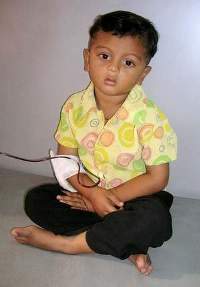Thalassemia is an inherited autosomal resessive blood disease resulting in a reduced rate of synthesis of the globin chains within hemoglobin. Anemia is the characteristic presenting sign of the thalassemias. 
Treatment begins in pediatric patients and includes chronic blood transfusion, iron chelation, splenectomy and allogeneic hematopoietic transplantation. Morbidity and mortality are related to chronic iron overload associated with life-long blood transfusions. Iron chelation is of particular importance. Low ferritin levels are associated with a lower probability of heart failure and with prolonged survival.
68% of the patients live to the age of 35 years. 67% of the deaths are due to heart disease. The prevalence of complications are: heart failure 6.8%, arrhythmia 5.7%, hypogonadism 54.7%, hypothyroidism 10.8%, diabetes 6.4%, HIV infection 1.7%, and thrombosis 1.1%.
Chelation therapy includes intravenously or subcutaneously administered deferoxamine (Desferal™). TheraGenesis contributed to the clinical development and regulatory approval of orally administered deferoprone (Ferriprox™). This orally administered product represents a significant quality-of-life advantage for pediatric populations, who would otherwise require life-long iv or sc medical therapy.